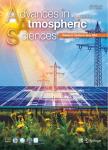An Effective Configuration of Ensemble Size and Horizontal Resolution for the NCEP GEFS
An Effective Configuration of Ensemble Size and Horizontal Resolution for the NCEP GEFS作者机构:Key Laboratory of Meteorological Disaster of Ministry of Education Nanjing University of Information Science & Technology Nanjing 210044 Environmental Modeling Center/NCEP/NOAA Camp Springs MD 20746 USA UCAR Boulder CO 80307 USA I.M. Systems Group Inc. (IMSG) at the Environmental Modeling Center/NCEP/NOAA Camp Springs MD 20746 USA
出 版 物:《Advances in Atmospheric Sciences》 (大气科学进展(英文版))
年 卷 期:2012年第29卷第4期
页 面:782-794页
核心收录:
学科分类:07[理学] 070601[理学-气象学] 0706[理学-大气科学]
基 金:EMC
主 题:NCEP operational GEFS ensemble size horizontal resolution ensemble mean tbrecast probabilistic forecast
摘 要:Two important questions are addressed in this paper using the Global Ensemble Forecast System (GEFS) from the National Centers for Environmental Prediction (NCEP): (1) How many ensemble members are needed to better represent forecast uncertainties with limited computational resources? (2) What is tile relative impact on forecast skill of increasing model resolution and ensemble size? Two-month experiments at T126L28 resolution were used to test the impact of varying the ensemble size from 5 to 80 members at the 500- hPa geopotential height. Results indicate that increasing the ensemble size leads to significant improvements in the performance for all forecast ranges when measured by probabilistic metrics, but these improvements are not significant beyond 20 members for long forecast ranges when measured by deterministic metrics. An ensemble of 20 to 30 members is the most effective configuration of ensemble sizes by quantifying the tradeoff between ensemble performance and the cost of computational resources. Two representative configurations of the GEFS the T126L28 model with 70 members and the T190L28 model with 20 members, which have equivalent computing costs--were compared. Results confirm that, for the NCEP GEFS, increasing the model resolution is more (less) beneficial than increasing the ensemble size for a short (long) forecast range.



